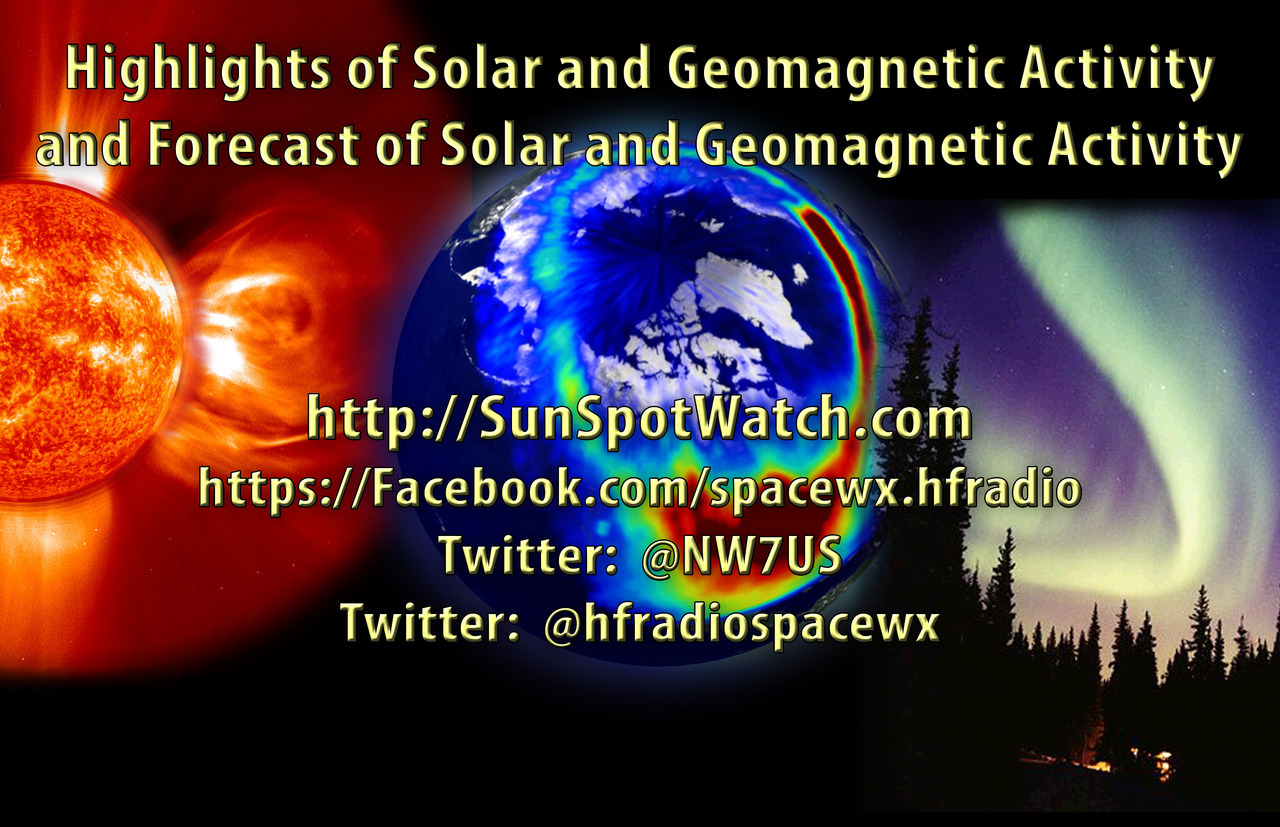 Weekly Propagation Summary – 2018 Aug 27 16:10 UTC
Weekly Propagation Summary – 2018 Aug 27 16:10 UTC
Here is this week’s space weather and geophysical report, issued 2018 Aug 27 0539 UTC.
Highlights of Solar and Geomagnetic Activity 20 – 26 August 2018
Solar activity was at very low levels. Regions 2719 (S07, L=131, class/area Cro/040 on 23 Aug) and 2720 (N08, L=136, class/area Dao/100 on 25 Aug) developed on the solar disk on 18 Aug and 23 Aug respectively. Both regions were responsible for several low level B-class flares. The largest was a B4 flare at 25/1048 UTC from Region 2720. Other activity included two coronal mass ejections (CME) observed on 19 and 20 Aug. The first was a narrow CME off the SW limb at 19/0812 UTC in SOHO/LASCO C2 imagery. The CME originated from a filament eruption near S09W06 at 19/0542 UTC. The latter CME was caused by a filament eruption at approximately 20/1100 UTC from the NW quadrant. An associated faint partial halo CME was observed off the W/SW limb at 20/2136 UTC in C2 imagery. WSA/ENLIL modelling of the events showed only weak effects from possible glancing blows late on 21 Aug and late on 24 Aug.
No proton events were observed at geosynchronous orbit.
The greater than 2 MeV electron flux at geosynchronous orbit reached high levels throughout the period. The largest flux of the period was 10,300 pfu observed at 21/2150 UTC.
Geomagnetic field activity ranged from quiet to G3 (Strong) geomagnetic storm levels. The period began under the influence of a negative polarity coronal hole high speed stream (CH HSS). Solar wind speeds were elevated to near 670 km/s with total field initially at 12 nT on 20 Aug. By 21 Aug, solar wind speed was in decline while total field was at 5 nT or less. Solar wind slowly decreased over the next few days as nominal conditions were reached by 23 Aug. The geomagnetic field responded with quiet to active levels on 20 Aug, quiet to unsettled levels on 21-22 Aug and quiet levels on 23 Aug. By 24 Aug, a small discontinuity could be seen in the total field. A small increase to 7 nT was observed at 24/1116 UTC while the Bz component deflected southward to -6 nT, however the solar wind speed continued to decrease to near 325 km/s by the end of the day. As a result, quiet to unsettled levels were observed on 24 Aug. By 25 Aug, solar wind speed increased briefly to 460 km/s at 25/1305 UTC before declining once again, however total field began to increase beginning at 25/1210 UTC as effects from the 20 Aug CME were beginning. By 26 Aug, total field increased to 18 nT and remained there for approximately 12 hours. The Bz component was mostly negative reaching a maximum of -17 nT for approximately 24 hours beginning at 25/1600 UTC. Solar wind speed once again showed an increase at 26/0730 UTC from 370 km/s to near 550 km/s by the periods end as the solar wind stream was transitioning into a positive polarity CH HSS. The geomagnetic field responded with quiet to active levels on 25 Aug and unsettled to G3 (Strong) storm levels on 26 Aug.
Forecast of Solar and Geomagnetic Activity 27 August – 22 September 2018
Solar activity is expected to be at very low levels with a slight chance for C-class flare activity on 27-29 Aug and again on 11-22 Sep as Regions 2719 and 2720 return to the visible disk. Very low levels are expected for the rest of the forecast period.
No proton events are expected at geosynchronous orbit.
The greater than 2 MeV electron flux at geosynchronous orbit is expected to be at high levels on 27 Aug-03 Sep, 12-15 Sep, and again on 17-19 Sep due to recurrent CH HSS influence.
Geomagnetic field activity is expected to be at unsettled to active levels on 27-30 Aug, 01-02 Sep, 07 Sep, 11-17 Sep, and 22 Sep with G1 (Minor) geomagnetic storm levels expected early on 27 Aug due to CH HSS activity.
Don’t forget to visit our live space weather and radio propagation web site, at: http://SunSpotWatch.com/
Live Aurora mapping is at http://aurora.sunspotwatch.com/
If you are on Twitter, please follow these two users: 1. https://Twitter.com/NW7US 2. https://Twitter.com/hfradiospacewx
– – – – – – – – – – – – –
Be sure to subscribe to our space weather and propagation email group, on Groups.io
https://groups.io/g/propagation-and-space-weather
Spread the word!
– – – – – – – – – – – – –
Links of interest:
+ Amazon space weather books: http://g.nw7us.us/fbssw-aSWSC
+ https://Twitter.com/NW7US
+ https://Twitter.com/hfradiospacewx
Space Weather and Ham Radio YouTube Channel News:
I am working on launching a YouTube channel overhaul, that includes series of videos about space weather, radio signal propagation, and more.
Additionally, I am working on improving the educational efforts via the email, Facebook, YouTube, Tumblr, and other activities.
You can help!
Please consider becoming a Patron of these space weather and radio communications services, beginning with the YouTube channel:
https://www.patreon.com/NW7US
The YouTube channel:
https://YouTube.com/NW7US
..














